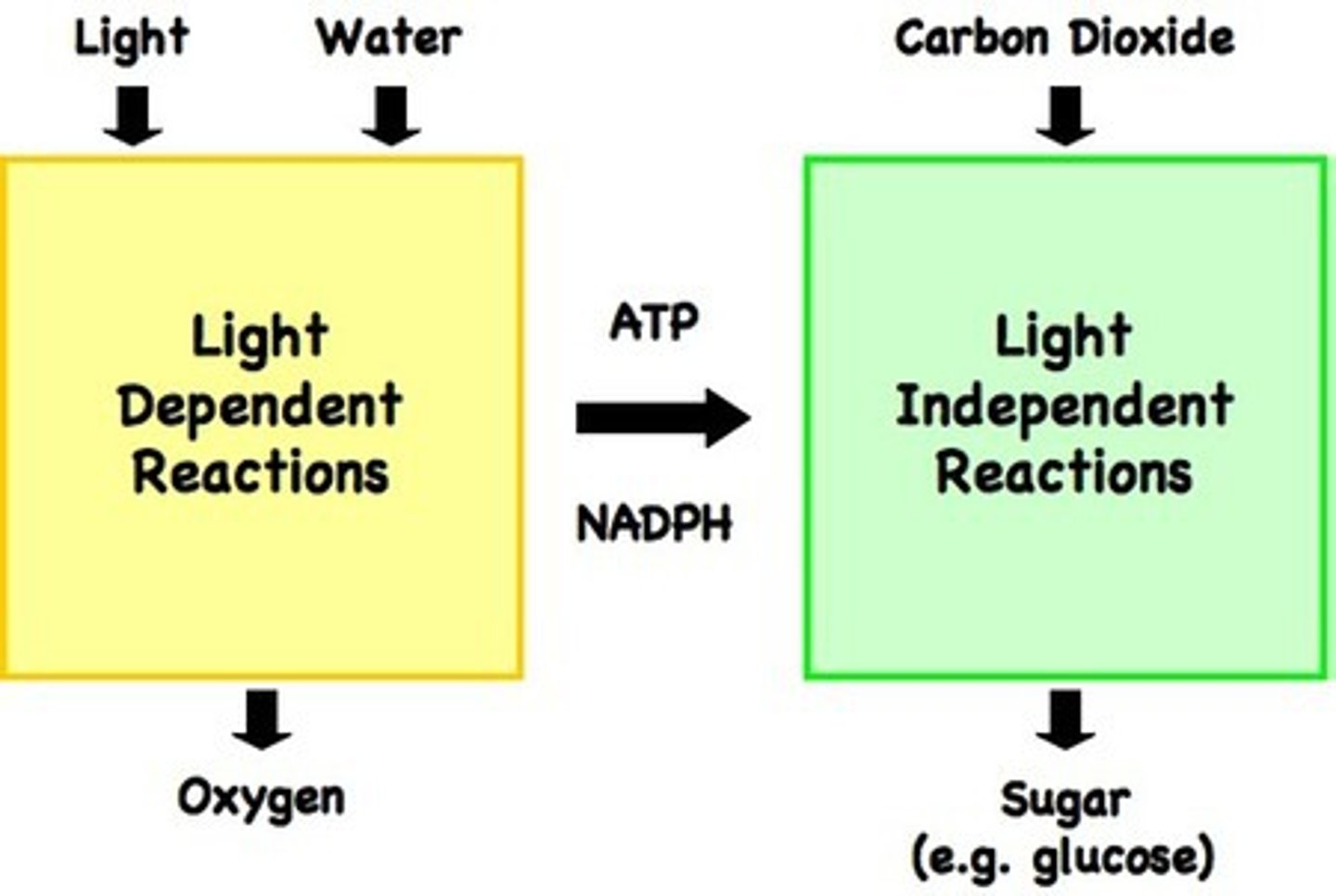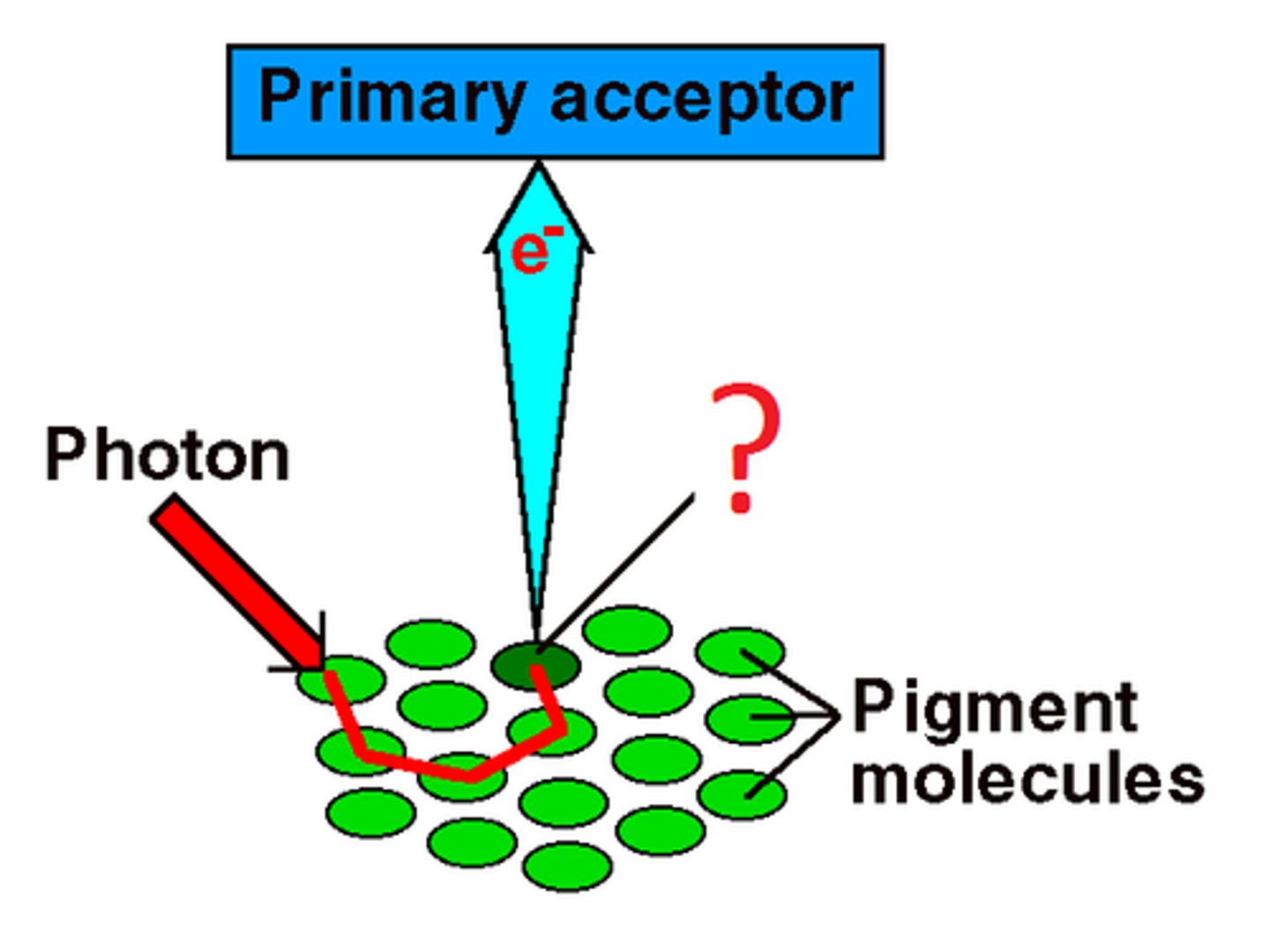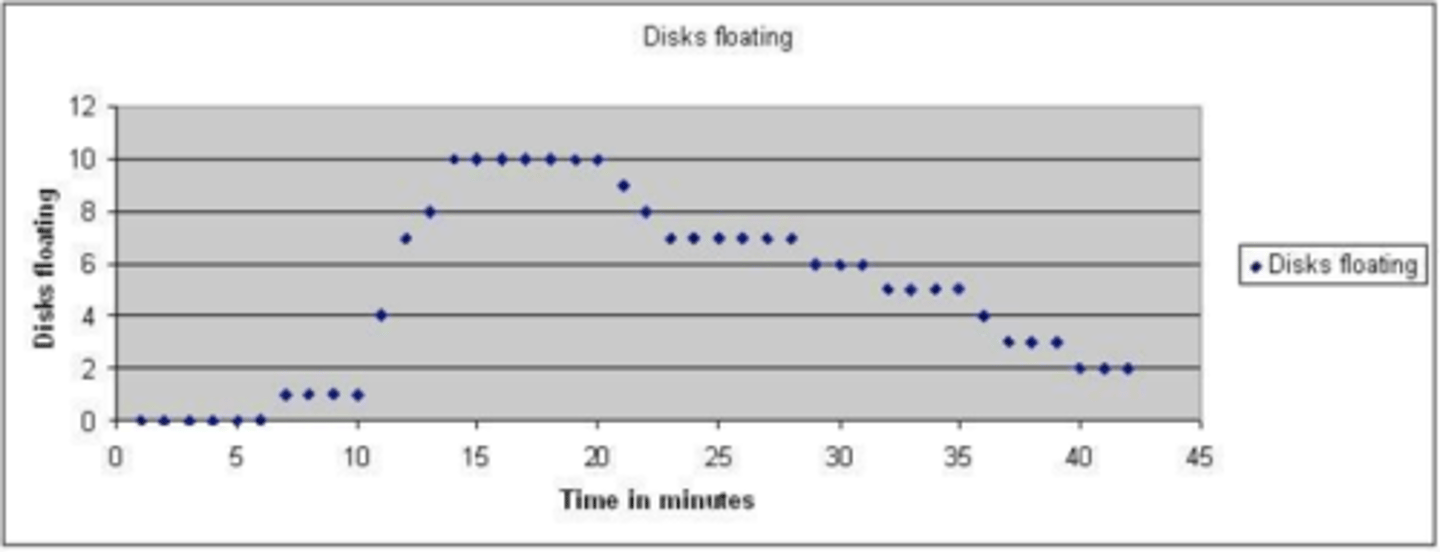AP Bio: Photosynthesis
1/46
There's no tags or description
Looks like no tags are added yet.
Name | Mastery | Learn | Test | Matching | Spaced |
|---|
No study sessions yet.
47 Terms
Why does light quality (wavelength) affect photosynthesis?
Different light wavelengths vary in effectiveness for driving photosynthesis. Chlorophyll pigments absorb blue and red light most efficiently, while green light is less absorbed. Light in effective wavelengths drives photosynthesis more efficiently.
what features of plant leaves affect the net rate of photosynthesis?
Leaf Surface Area:
How and Why: Larger surface areas allow for more light capture, increasing the potential for photosynthesis. Broad leaves can intercept more sunlight, which is crucial for driving the photosynthetic process.
Thickness of the Leaf:
How and Why: Thicker leaves generally contain more layers of mesophyll cells, which house chloroplasts. This can enhance the photosynthetic capacity. However, if a leaf is too thick, it might limit light penetration to lower layers.
Stomatal Density and Distribution:
How and Why: High stomatal density increases the potential for CO₂ uptake, which is essential for photosynthesis. Efficient distribution ensures that gas exchange occurs evenly across the leaf surface, optimizing CO₂ intake and O₂ release.
biochemical pathways
a series of reactions in which the product of one reaction becomes the substrate for the next reaction
Photo system II
Absorbs light in photosynthesis. It comes first (p680)
- loses an electron and becomes positively charged so it can split water and release electrons
- electrons transferred to photosystem I
-proton gradient that it creates leads to chemiosmosis and the formation of ATP
chemiosmosis (oxidative phosphorylation, light DEPENDENT reaction)
the process of converting ADP to ATP by using the proton gradient (across the thylakoid membrane) to force protons (produced from splitting of water from Photosystem II) through the turbine-like ATP synthase
- concentration of protons HIGHER in thylakoid membrane than in Stroma
Carbon Fixation (Calvin Cycle)
(Carbon fixation)
- CO2 diffuses into stroma
- enzyme called rubisco combines CO2 with a 5 carbon carbohydrate called RuBP
- the 6 carbon molecule that's produced is SPLIT into 3-carbon molecules called PGA
(Reduction)
- PGA receives a phosphate group and photon, producing ADP, NADP, phosphate
-produces PGAL (also called G3P)
(Regeneration) HAPPENS 6 TIMES TO MAKE ONE MOLECULE OF GLUCOSE
-some PGAL from reduction stage converted back to RuBP (5 carbon carb), some synthesizing glucose and fructose
- the sugars make the disaccharide sucrose
Regeneration (Calvin Cycle)
Most G3P is used in reactions that use ATP to regenerate RuBP
- PGAL from reduction stage converted back to RuBP (5 carbon carb), synthesizing glucose and fructose
- the sugars make the disaccharide sucrose
adaptations to minimize water loss
waxy cuticle and stomata
- CAM and C4 plants
what could you measure to determine the rate of photosynthesis?
- the production of oxygen, a byproduct of the light reactions
- the consumption of CO2, a key reactant in the dark reactions
what happens if you remove air from the spongy mesophyll of the leaf?
- they become denser than water, causing them to sink.
What role does nutrient availability play in photosynthesis?
Nutrients like nitrogen, magnesium, phosphorus, and potassium are essential for chlorophyll, ATP, and enzyme formation. Lack of nutrients limits chlorophyll production, ATP synthesis, and enzyme function, reducing the overall photosynthesis rate.
How does oxygen concentration impact photosynthesis?
High oxygen levels inhibit photosynthesis through photorespiration, where RuBisCO fixes oxygen instead of CO₂. This process consumes ATP, reduces efficiency, and lowers the photosynthesis rate.
what changes could be made to make the results of a lab using leaf disks and leaf buoyancy to measure the rate of oxygen production more conclusive?
Control Variables More Rigorously:
Ensure consistent environmental conditions (light intensity, temperature, CO₂ concentration) across all trials.
Replicate Trials:
Perform multiple trials for each condition to ensure consistent and reproducible results.
Use a Light Source with Known Intensity:
Utilize a calibrated light source and measure light intensity at the leaf disks to ensure consistent exposure.
Standardize Leaf Disk Preparation:
Use a uniform tool to punch out leaf disks of the same size and thickness from the same type of leaf.
Monitor and Adjust CO₂ Levels:
Add a controlled amount of bicarbonate to the solution to maintain consistent CO₂ levels across experiments.
cellular respiration
Process that releases energy by breaking down glucose and other food molecules in the presence of oxygen

Cellular respiration
Process that releases energy by breaking down glucose and other food molecules in the presence of oxygen
- releases CO2, water, energy
- creates ATP
photosynthesis reaction equation
6CO2 + 6H2O ------> C6H12O6 + 6O2

light reaction equation
sunlight + H2O ----- oxygen (waste) + NADPH + ATP

dark reaction equation
ATP + NADPH + CO2 ---> C6H12O6

Chloroplast
An organelle found in plant and algae cells where photosynthesis occurs
- absorb light energy during light dependent reactions
- double membrane organelles with an inner membrane folded into disc shaped sacs called thylakoids
Grana
the stacks of thylakoids embedded in the stroma of a chloroplast.
Thylakoid membrane
The photosynthetic membrane within a chloroplast that contains light gathering pigment molecules and electron transport chains. (Contains chlorophyll)
Stroma
fluid portion of the chloroplast; outside of the thylakoids
Chlorophyll a and b absorb only...
Red, blue, violet light
Carotenoids
An accessory pigment, either yellow or orange, in the chloroplasts of plants. By absorbing wavelengths of light that chlorophyll cannot, carotenoids broaden the spectrum of colors that can drive photosynthesis.
light-dependent reactions
H2O + light energy -> O2 + ATP + NADPH
reactions of photosynthesis that use energy from light to produce ATP and NADPH
- water splits, giving off oxygen and hydrogen
- light is absorbed by chlorophyll a that excites the electrons in the chlorophyll molecule
- electrons passed through a series of carriers and ATP is produced
- in the THYLAKOIDS
Where is the light independent reaction?
stroma
Where is the light dependent reaction?
thylakoid membrane
Electron transport chain
A sequence of electron carrier molecules (membrane proteins) that shuttle electrons during the redox reactions that release energy used to make ATP.
Antenna pigments
Pigments that capture photon energy and funnel it to the reaction center
Photosystem
cluster of chlorophyll and proteins found in thylakoids
- unit of several hundred antenna pigments
Dark Reactions (Calvin Cycle)
Second step of photosynthesis where chemical energy is used to make sugar (Glucose)
- CO2 splits, ultimate product is glucose
- depends on PRODUCTS of light reaction
- includes the Calvin cycle
- in the STROMA
Thylakoid lumen
A fluid-filled interior space enclosed by the thylakoid membrane.
Photosystem I
P700, makes NADPH, does not take place first
- excited electrons activate P700 which reduces NADP+ to NADPH
- NADPH is needed in the Calvin Cycle
Calvin cycle
light-independent reactions of photosynthesis in which energy from ATP and NADPH is used to build high-energy compounds such as sugar
1. Carbon fixation
2. Reduction
PGA
phosphoglycerate; a three-carbon molecule formed in the first step of the Calvin cycle
Reduction (Calvin Cycle)
- each PGA receives a phosphate group from a molecule of ATP
- receives a proton from NADPH, releasing a phosphate group + producing PGAL (also called G3P)
- reactions produce ADP, NADP, phosphate (which are used again in the light reactions)
C4 plants
A plant in which the Calvin cycle is preceded by reactions that incorporate CO2 into a four-carbon compound (oxaloacetate) in mesophyll cells, where CO2 is released and enters the calvin cycle.
This adaptation helps minimize photorespiration and is beneficial in hot, dry environments
CAM plants
plants close their stomata during the day, collect CO2 at night, and store the CO2 in the form of acids until it is needed during the day for photosynthesis
reaction center chlorophyll
in a photosystem, a chlorophyll molecule in which electrons excited by light energy are passed to an acceptor molecule that is the initial carrier of an electron transport chain

Lamellae
connects and separates thylakoid stacks (grana), maximising photosynthetic efficiency
Stomata
pores on the leaf where O2 exits and CO2 enters
how is the buoyancy of a leaf disk an indicator of the net rate of photosynthesis?
The buoyancy of a leaf disk is an indicator of the net rate of photosynthesis due to the oxygen produced.
- leaf disks are made to sink by removing air from their intercellular spaces.
- When exposed to light, photosynthesis produces oxygen within the leaf, which accumulates in these spaces and reduces the disk's density. As oxygen accumulates, the disks become buoyant and rise. The faster the disks float, the higher the net rate of photosynthesis, reflecting the balance between oxygen production in photosynthesis and oxygen consumption in respiration.
-This method allows scientists to measure and study the effects of various factors on photosynthesis rates.
how does air return to the spongy mesophyll of the leaf?
the guard cell opens the stoma, allowing for air to return to the spaces
What is the effect of light intensity on the rate of photosynthesis?
Light intensity initially increases the rate of photosynthesis proportionally by providing more photons to drive the reactions. However, the rate plateaus due to saturation of the photosynthetic apparatus and other limiting factors like CO₂ concentration or temperature.
How does carbon dioxide concentration affect photosynthesis?
Increasing CO₂ concentration enhances photosynthesis by providing more substrate for carbon fixation in the Calvin cycle. However, the rate plateaus due to saturation or other limiting factors.
Explain the impact of temperature on photosynthesis.
Temperature affects enzymatic reactions in photosynthesis. Rate increases with temperature up to an optimum point due to accelerated enzyme activity. Beyond the optimum, the rate declines as enzymes denature and physiological processes are affected.
in this graph (the other side): why do the disks begin to sink?
0-14 mins: discs rise because of photosynthesis, and at 13 mins max # of discs are floating
14-20 mins: 10 discs still float because of balance of CO2 and O2 in the spongy mesophyll, but photosynthesis stops in this time (light reactions)
20 mins: discs begin to sink bc photosynthesis has stopped, no more O2 being produced
cellular respiration continues in cells, which uses up O2 in spongy mesophyll, and leaves lose their buoyancy
